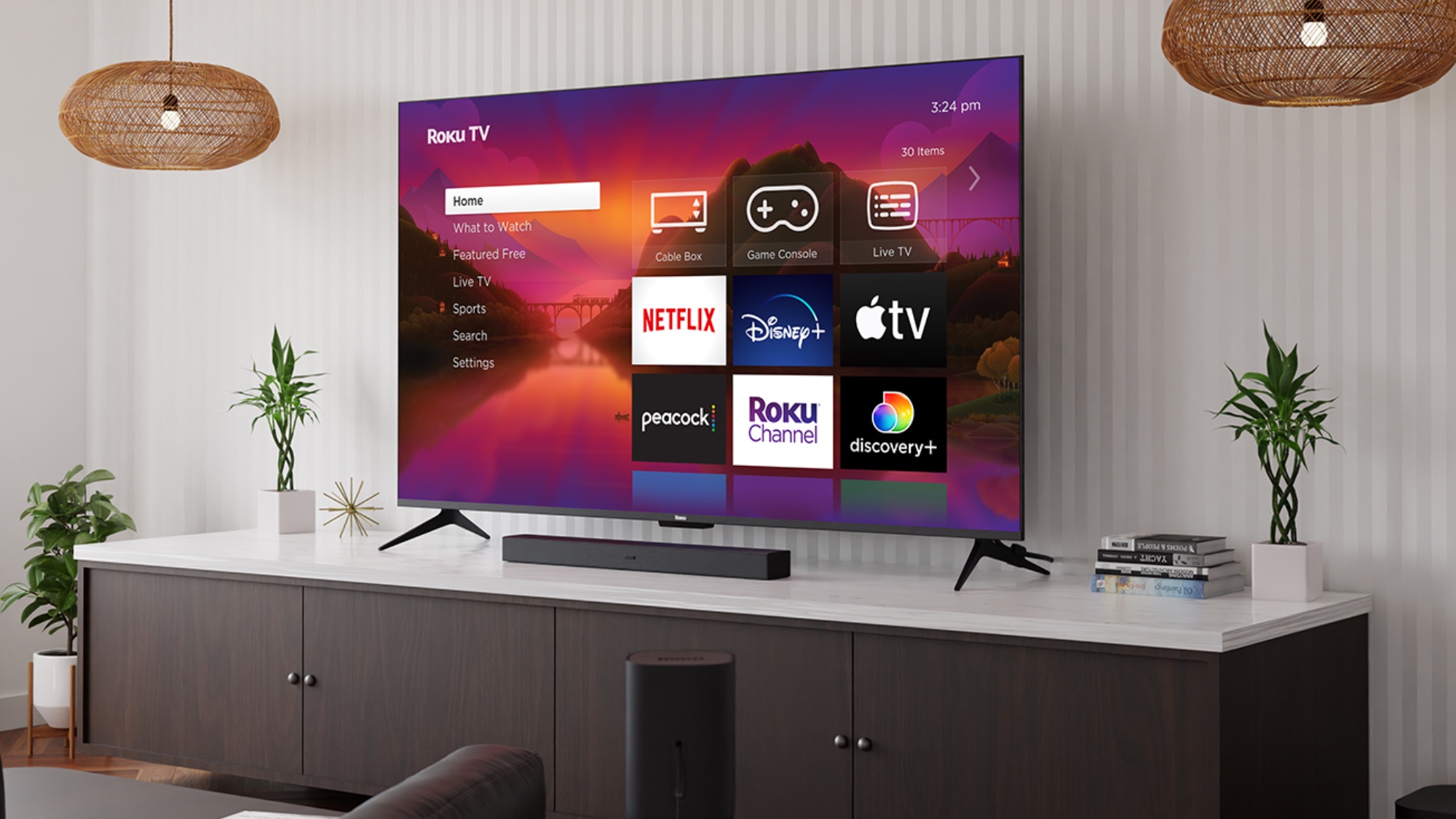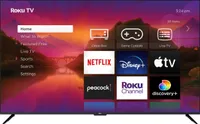
Usually, if a TV costs under $500, we don’t expect it to ace our suite of video tests. And trust us, they're pretty rigorous tests.
We use high-end equipment like the X-Rite i1 Pro spectrophotometer, a SpectraCal VideoForge Pro pattern generator and Portrait Displays’ Calman calibration software to put a TV through a stress test to see just how good its color saturation, color accuracy and peak brightness are.
It’s this suite of tests that produces the data we need to confidently say that the Sony A95K OLED, Samsung QN95B QLED and LG C2 OLED are some of the best TVs out there.
We recently put the Roku Plus Series QLED, currently priced at just $499 at Best Buy, through its paces and what we found surprised us. It aced them…well, most of them. There’s one area in which it fell short, but compared to the competition — it’s still a rock-solid TV.
The Roku Plus test results
| Row 0 - Cell 0 | Roku Plus Series QLED | Hisense U6H |
| Price (55-inch) | $499 | $429 |
| SDR Brightness (10%, in nits) | 531.89 | 565.27 |
| Delta-E (lower is better) | 2.6011 | 2.9942 |
| Rec. 709 Gamut Coverage | 99.86% | 99.79% |
| HDR Brightness (25%) | 727.04 | 664.87 |
| UHDA-P3 Gamut Coverage | 95.8% | 90.9% |
| Rec. 2020 Gamut Coverage | 80.54% | 69.19% |
Let’s start with the good news: The Roku Plus Series QLED performs exceptionally well when it comes to color accuracy and color saturation, due in no small part to its use of quantum dots.
We measured the TV’s Rec 709 color gamut — the percentage of colors included in the industry standard Rec 709 color space — to be around 99.9% in its Standard picture setting. When you move over to Movie Mode, its color accuracy — measured by a metric called Delta E — was a jaw-dropping 2.6 (lower is better here).
Those color gamut performance numbers rival what we’ve seen on TVs like the TCL 6-Series R655, one of our top-performing TVs under $1,000.
Get instant access to breaking news, the hottest reviews, great deals and helpful tips.
It's also a marked improvement on the Hisense U6H, a TV we thought might become the best TV under $500. The competition is close, but the Roku pulls ahead in HDR brightness and color saturation.
So where do things go wrong for both these TVs? Brightness and specifically their inability to reach the 1,000-nit threshold that’s necessary to properly display HDR content.
Why 1,000 nits is the magic number
To make sure we gave the Roku Plus a fair shake, we tested its brightness in five different HDR modes — Darker, Dark, Normal, Bright and Brighter. As you’d expect, the Brighter HDR mode delivered the highest peak brightness of 727 nits in a 25% window, while Darkest topped out at 383 nits.
For a midrange model, these are the numbers we expect to see — they’re just not quite the numbers you need to properly appreciate HDR content.
It might seem like an arbitrary number, however 1,000 nits is the sweet spot for one very important reason: It’s the brightness that most HDR movies and TV shows are mastered in.
If you don’t speak production lingo, most of the things you watch were made to be displayed on a screen that has a 1,000-nit peak brightness. Any less and you’re not getting the full effect of what directors and editors intend in their films and shows. Because the Roku Plus tops out at 727 nits, there’s a lot of details that you’d be missing out on.
But don’t write the Roku Plus off yet
Until we put the Roku Plus through the rest of our testing, which involves lots of movie watching and game playing, we can’t tell you whether or not we recommend it. However, based on the numbers it put up in our tests, things are looking good for the Roku Plus.
In fact, compared to some of its stablemates in its price range, the Roku Plus looks great.
If you want to compare it apples-to-apples to the TCL 6-Series, the Roku Plus holds its own. Its input lag is higher and its Rec 2020 coverage (another color gamut metric) is lower, but the $649 Roku Plus is competing with a TV that’s typically $1,000.
It’s that way for most of the TVs in its price range — the LG A2 OLED, the Samsung Q80B, Hisense U8H, Vizio M-Series Quantum X and Sony X90K.
| Row 0 - Cell 0 | Sony X90K | Hisense U8H | TCL Series-6 Roku TV | Vizio M-Series Quantum |
| Price (55-inch) | $999 | $699 | $699 | $498 (50-inch) |
| SDR Brightness (10%, in nits) | 481 | 1,596 | 522 | 116 |
| Delta-E (lower is better) | 1.5401 | 3.5586 | 4.0367 | 3.1662 |
| Rec. 709 Gamut Coverage | 98.93% | 99.15% | 96.59% | 94.87% |
| HDR Brightness (10%) | 1,027 | 1,964 | 970 | 796 |
| UHDA-P3 Gamut Coverage | 95.63% | 97.13 | 96.35% | 95.12% |
| Rec. 2020 Gamut Coverage | 72.95% | 80.02% | 76.93% | 81.05% |
It doesn’t beat them in every category (especially in brightness where it’s trounced by the TCL, Hisense and Sony) but it’s standing against them pretty well. Where brightness is concerned, the Roku Plus still falls short but it’s a heck of a lot closer in the other categories than any $650 TV should be.
In both the Roku Plus Series QLED and, to a lesser extent, the Hisense U6H, we're starting to see a new realm of mid-range TVs at a new lower price tag — and that's something everyone can get excited about.
Roku TV 55" Plus Series 4K QLED TV: was $649 now $499 @ Best Buy
The Plus Series features a QLED screen along with full array local dimming. You also get Dolby Vision/HDR 10 Plus/HLG support, Apple HomeKit/Alexa/Google Assistant support, and four HDMI ports (one is HDMI 2.1). Made by Roku, this TV features Roku's platform for all your streaming needs. This Best Buy exclusive is on sale for the first time.
Roku TV 75" Plus Series 4K QLED TV: was $1,199 now $999 @ Best Buy
This 75-inch model is the biggest TV in Roku's new lineup. As part of the Plus Series, it features a QLED screen along with full array local dimming. You also get Dolby Vision/HDR 10 Plus/HLG support, Apple HomeKit/Alexa/Google Assistant support, and four HDMI ports (one is HDMI 2.1).

Nick Pino heads up the TV and AV verticals at Tom's Guide and covers everything from OLED TVs to the latest wireless headphones. He was formerly the Senior Editor, TV and AV at TechRadar (Tom's Guide's sister site) and has previously written for GamesRadar, Official Xbox Magazine, PC Gamer and other outlets over the last decade. Not sure which TV you should buy? Drop him an email or tweet him on Twitter and he can help you out.

